|
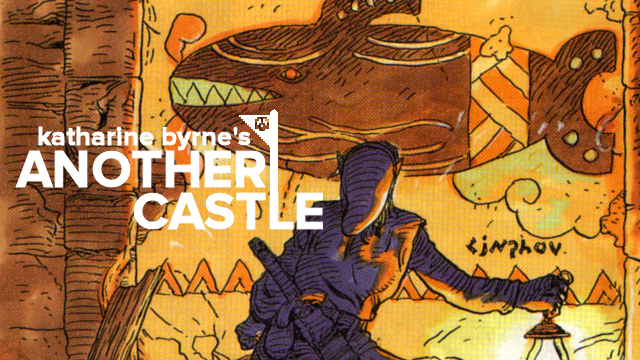
Dream worlds. We either love ‘em, or we really, really, really hate them. We go absolutely ga-ga for them in films and literature, but whenever it comes to video games, they’re quite possibly one of the most hated plot devices of all time. It’s a fair cop too– they’re lazy, they rarely produce the same kind of thought-provoking conclusions as films like Inception and Eternal Sunshine of the Spotless Mind or books like Alice in Wonderland, and there’s simply nothing worse than struggling against nigh on impossible bosses for hours on end only to be told at the credits screen that, “Hey, you know that game you’ve just been playing? Well, it’s all just a dream! How about that for a laugh, eh?”
But there’s one game that I think manages to defy this hallowed convention of tacked-on dream endings, and that’s The Legend of Zelda: Link’s Awakening, the brainchild of Yoshiaki “Majora’s Mask” Koizumi. You might not think it, given the fact it starts like so many other dream world games (i.e.: we have no idea about the horrible twist lying in wait for us), but Link’s Awakening goes one step further and makes dreams and the idea of dreaming a central part of its overall story– something that most games sadly seem to forget.
So let’s talk a bit more about that standard opening. As far as we know, Link’s ship is destroyed in a storm and he washes up on the shore of the nearby island of Koholint. He’s found unconscious by a young girl named Marin, and she takes him back to her house in Mabe Village. She cares for him until he wakes up (an idea that would set the stage for nearly every Zelda opening for the next twenty years), and suggests he might want to go down to the beach to see if any of his belongings have washed up since the shipwreck. So far, so straightforward. Just before he leaves, however, Marin warns him that “lots of nasty monsters have been in the area” since she found him– but hey, this is a Zelda game, after all. We eat monsters for breakfast.
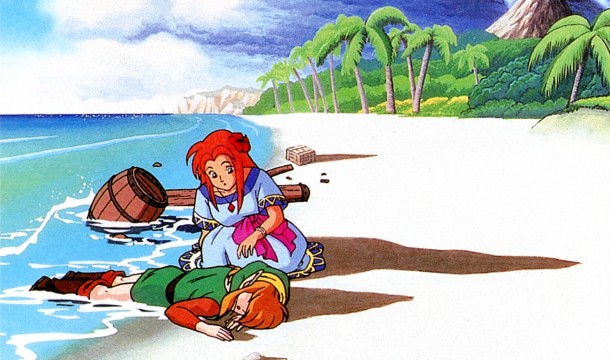
Don’t get too attached, lady. We’ll be turning into a Deku Scrub in seven years time…
Yet we can tell there’s something odd about this game right from the moment we set foot outside, and it’s this gradual unravelling of reality that really makes Link’s Awakening stand out from the crowd. For starters, there’s a Chain Chomp straight out of Mario that’s chained up outside the house next door (with another tiny one inside who talks non-stop about jewels, make-up and dresses!). Goombas and piranha plants also make an appearance in some its later platforming sections, and we soon find there’s a Yoshi doll in the local game shop as well. Of course, these may be nothing more than fun, harmless cameos, but they nevertheless work to offset the tone of Link’s adventure as soon as we step out of the door, hinting that maybe not all is what it seems here.
The villagers, too, seem oddly self-aware that this is a game, spouting nonsensical tips like, “Hey man! When you want to save just push all the buttons at once! Uhh… Don’t ask me what that means, I’m just a kid!” I’ll admit it’s certainly one of the more comedic tutorials I’ve ever come across in my years of gaming, but this too helps the game feel even more off-kilter than before. It’s like everyone’s had part of their memory removed and they’ve been left with nothing but disparate pieces of information that make absolutely no sense whatsoever in the context of their surroundings.
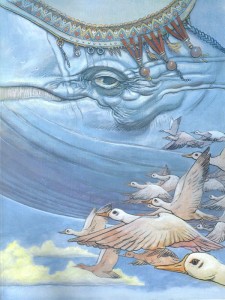 Things get a whole lot weirder, though, when you meet Papahl, another one of Mabe Village’s slightly kooky residents. He starts off relatively sane, talking about his newborn sons, but then he says this: “I’ll be lost in the hills later, so keep a look out for me, hear?” Wait, what? He knows he’s going to get lost and is telling us to look out for him? Okay… Is that even physically possible? To actively know you’re going to get lost? It’s a moment that’s made many gamers do a bit of a double take over the years, but sure enough, Papahl does indeed get lost later on, only he’s so famished when you find him that he can’t even move. So… you somehow have the power to predict you’ll get lost but not enough foresight to pack enough provisions to tide you over? That’s some messed up logic right there…
Things get a whole lot weirder, though, when you meet Papahl, another one of Mabe Village’s slightly kooky residents. He starts off relatively sane, talking about his newborn sons, but then he says this: “I’ll be lost in the hills later, so keep a look out for me, hear?” Wait, what? He knows he’s going to get lost and is telling us to look out for him? Okay… Is that even physically possible? To actively know you’re going to get lost? It’s a moment that’s made many gamers do a bit of a double take over the years, but sure enough, Papahl does indeed get lost later on, only he’s so famished when you find him that he can’t even move. So… you somehow have the power to predict you’ll get lost but not enough foresight to pack enough provisions to tide you over? That’s some messed up logic right there…
We quickly discover, though, that Koholint is no ordinary island. In fact, it’s a dream invented by a deity known as the Wind Fish, and waking him up is the only way Link can escape the island and return to Hyrule– which is all revealed to us by a talking owl no less (remember this was five years before Ocarina of Time‘s Kaepora Gaebora made talking owls seem completely normal). But before I get into what this means for Link and his newfound friends, I want to spend a few moments talking about Koholint itself, because you have to admit, it’s not exactly the most obvious kind of dream world, is it? The Mario cameos and the self-aware characters may give the odd hint here and there that something’s amiss, but it’s this pervading sense of eerie familiarity which is precisely what sets it apart from other, lesser dream worlds, and if we compare Koholint to, say, Subcon from Super Mario Bros. 2, the differences are immediately apparent.
With its relentless floating masks that hound you from one dimension to the next and its strange bird-head maws transporting you from one world to the other, Subcon is very much in the “bizarro world” category when it comes to fantastical dreamscapes. Okay, so the Mushroom Kingdom wasn’t exactly “normal” either, but Subcon really does take the biscuit here. Doors magically appear out of smashed bottles (which in turn lead to alternate dimensions), Mario throws bombs around, of all things, and lest we forget it was also the game that gave birth to Birdo. Of course, part of this marked weirdness comes down to the fact that the Western version of Super Mario Bros. 2 was, in fact, a re-skin of Japanese platformer Yume Kōjō: Doki Doki Panic (which translates to Dream Factory: Heart-Pounding Panic), but this just serves to heighten its overall peculiarity.
The only glimpse we get of even a remotely similar landscape in Link’s Awakening, on the other hand, is when Link enters the Dream Shrine to obtain the legendary ocarina. But even this is a relatively tame comparison, as the Dream Shrine’s main chamber is also very much like any other Zelda dungeon. It’s a square room with two chests in it, and Link must use his Pegasus Boots to whisk himself across the cracked single-track pathway around the raised platform in the middle. The only clue we’re given to indicate this is typical dreamscape territory is the music, which features a very thinly textured, high-pitched melody accompanied by an almost crazed-sounding counter-melody.
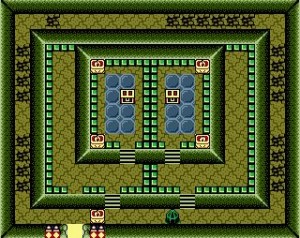
If we’d known dream worlds could be this ordinary, we probably would have been less surprised about Super Mario Bros. 2…
But here’s where it gets interesting, because Link’s dream about getting the ocarina is, in fact, a dream inside the Wind Fish’s dream. That’s two layers of dreaming going on there, pre-dating Inception‘s tangled plains of reality by over a decade. It’s also never made clear what’s happened to Link’s real body in the game either. Has he been incorporated body and mind into the Wind Fish’s dream, or is he still, in fact, floating round in the ocean, dreaming that he’s in the Wind Fish’s dream (potentially making the episode in the Dream Chamber three layers of dreaming)? But even if we only focus on two layers of dreams, that in itself raises a lot of questions. Is it possible to dream about someone dreaming in your own dream? And was that dream within a dream even a dream at all if Link woke up with the ocarina sitting in his inventory? Man, that’s a lot of dreams…
Pages: 1 2




 ShareThis
ShareThis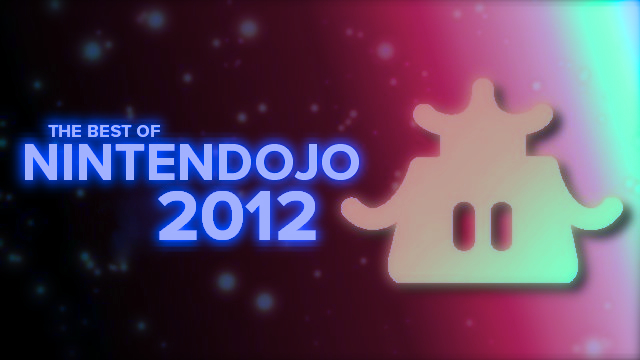








That was a great read! Link’s Awakening is my favorite game of all time, and for as many times as I’ve played it I never thought of some of the points you brought up.
Sweet genius, this is amazing. Thank you for that insightful read. I remember the Wind Fish saying that he and Link were dreaming the same dream, as though doing so simultaneously (which provides another tie to Inception). I’m curious to know what questions you have in mind regarding the possibility of Koholint being Link’s subconscious invention.